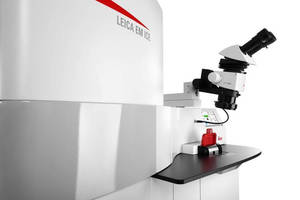High Pressure Freezer integrates light stimulation option.
Press Release Summary:

Able to cryo-immobilize samples without introducing structural alteration, Leica EM ICE lets users synchronize high-pressure freezing and light stimulation with 1 msec precision to capture dynamic phenomena and further analyze them at nanometer resolution. There are 5 wavelengths for light stimulation, and up to 9 samples can be frozen consecutively with sample storage system. Light stimulation can be performed with different wavelengths due to built-in connection for LED light modules.
Original Press Release:
New Insights are Just a Millisecond Away
Leica Microsystems Launches High Pressure Freezer with Integrated Light Stimulation for “Flash-and-Freeze” Experiments
Vienna, Austria. Leica Microsystems launches the Leica EM ICE, a new generation High-Pressure Freezer with fully integrated light stimulation option at the precision of a millisecond. High pressure freezing is currently the only method for preserving aqueous samples in their close-to-native state at nanometer resolution. The Leica EM ICE not only enables users to cryo-immobilize samples without introducing structural alteration, but it gives researchers the possibility to design novel experiments as the Leica EM ICE offers the combination of high pressure freezing and light stimulation. The instrument enables users to synchronize high-pressure freezing and light stimulation with the precision of a millisecond, capturing dynamic phenomena to further analyse them at nanometer resolution. The precise correlation between the light impulse and the time of freezing is essential for revealing the intricate changes in fine structure and fundamental processes in life science and industry research. The instrument offers five different wavelengths for light stimulation and can freeze up to nine samples consecutively with its new sample storage system. Samples are frozen within one second of having been placed in the specimen carrier and brought to liquid nitrogen temperatures (-195.7°C) at which they will be stored until further processed.
Dr. Cveta Tomova, Product Manager at Leica Microsystems says: “The Leica EM ICE is a powerful tool that can bring to light new discoveries and even help understand life-sustaining processes. It is the only instrument capable of synchronizing high pressure freezing and light stimulation with a millisecond precision. The platform brings together light, time, and sample preservation on a new level. This is a combination of quality and technological innovation, designed to assist researchers in achieving scientific break-throughs. High pressure freezing combined with light stimulation can be applied to any light-sensitive compound such as lotions, photoactivatable composite materials, proteins, and various biological samples. It can push further our understanding of highly dynamic processes, such as neurotransmission at the synapse.”
Light stimulation with the Leica EM ICE can be performed with different wave-lengths, i.e. blue, UV, green, red, and amber. This is possible with the inbuilt connection for the LED light modules, which the instrument software automatically recognizes. The software-integrated programming offers a range of parameters to assist scientists in designing “flash-and-freeze” experiments. The integrated light stimulation of the Leica EM ICE facilitates precise correlation between the light stimulus and the moment of freezing. “All this brings standardisation, reliability and at the same time flexibility to facilitate research in various scientific fields,” says Tomova.
Time is of essence, particularly for optimal sample preservation. The automated freezing cycle of the Leica EM ICE ensures the sample is frozen within a second after being placed in the specimen carrier. The computerized process starts with simultaneous cartridge assembly and initiation of the freezing process and is completed with the automatic sample release into the liquid nitrogen storage container, thereby preventing devitrification artefacts.
Users can freeze up to nine samples consecutively which helps them focus on the essentials and not the handling details. The Leica EM ICE sample storage Dewar has a programmable storage sequence for three separate positions. This permits freezing combinations of different samples or different conditions of the same sample subsequently.
In electron microscopy sample preparation, Leica Microsystems focuses on workflow solutions. The Leica EM ICE is a key part of multiple workflows. “Our ultimate goal is to help our customers obtain the breakthrough insights they strive for. This is why we provide the technology which can do what instruments before could not,” says Tomova. “At the same time, our goal is to bring comfort and consistency to researchers’ tasks. One example: To understand the complex changes in the fine structure of a sun-screen lotion exposed to UV light, a sample can be high pressure frozen in the Leica EM ICE with light stimulation under a specific doze of UV exposure. The frozen sample can then be coated in the high vacuum coater Leica EM ACE600 – still under cryo conditions – and then imaged in the cryo scanning electron microscope. The transport system Leica EM VCT100 serves as a shuttle from one step to the next, always preserving cryo and vaccum conditions.”
More about the product on Leica Microsytems’ website: http://www.leica-microsystems.com/products/em-sample-prep/industrial-materials/cryo-preparation/details/product/leica-em-ice/
Webinar on “flash-and-freeze” experiments by Prof. Erik Jørgenson and Dr. Shigeki Watanabe http://www.leica-microsystems.com/science-lab/webinar-flash-and-freeze-time-resolved-electron-microscopy/
Introduction to high-pressure freezing and why it is currently the only way to fix cellular constituents without introducing significant structural alterations: http://www.leica-microsystems.com/science-lab/brief-introduction-to-high-pressure-freezing/
About Leica Microsystems
Leica Microsystems develops and manufactures microscopes and scientific instruments for the analysis of microstructures and nanostructures. Ever since the company started as a family business in the nineteenth century, its instruments have been widely recognized for their optical precision and innovative technology. It is one of the market leaders in compound and stereo microscopy, digital microscopy, confocal laser scanning microscopy with related imaging systems, electron microscopy sample preparation, and surgical microscopes.
Leica Microsystems has seven major plants and product development sites around the world. The company is represented in over 100 countries, has sales and service organizations in 20 countries, and an international network of distribution partners. Its headquarters are located in Wetzlar, Germany.




